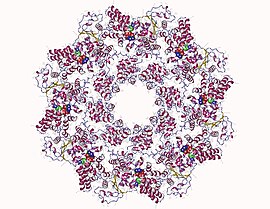| ADP-ribosyl cyclase/cyclic ADP-ribose hydrolase | |||||||||
|---|---|---|---|---|---|---|---|---|---|
 ADP-ribosyl cyclase homooctamer, Human | |||||||||
| Identifiers | |||||||||
| EC no. | 3.2.2.6 | ||||||||
| CAS no. | 9025-46-1 | ||||||||
| Databases | |||||||||
| IntEnz | IntEnz view | ||||||||
| BRENDA | BRENDA entry | ||||||||
| ExPASy | NiceZyme view | ||||||||
| KEGG | KEGG entry | ||||||||
| MetaCyc | metabolic pathway | ||||||||
| PRIAM | profile | ||||||||
| PDB structures | RCSB PDB PDBe PDBsum | ||||||||
| Gene Ontology | AmiGO / QuickGO | ||||||||
| |||||||||
In enzymology, a ADP-ribosyl cyclase/cyclic ADP-ribose hydrolase (EC 3.2.2.6) is a bifunctional enzyme that catalyzes the chemical reaction
- NAD+ + H2O cADPR + H2O + nicotinamide ADP-ribose + nicotinamide
The 3 substrates of this enzyme are NAD+ and H2O, whereas its two products are ADP-ribose and nicotinamide. The reaction proceeds through cyclic ADP-ribose (cADPR) as intermediate, which is then hydrolyzed into ADP-ribose. This makes it different from NAD+ glycohydrolase (EC 3.2.2.5), where the reaction does not proceed through cADPR.[1][2]
This enzyme belongs to the family of hydrolases, specifically those glycosylases that hydrolyse N-glycosyl compounds. Other names of this enzyme in common use include nicotinamide adenine dinucleotide (phosphate) nucleosidase, triphosphopyridine nucleotidase, NAD(P) nucleosidase, NAD(P)ase, and nicotinamide adenine dinucleotide (phosphate) glycohydrolase. This enzyme participates in nicotinate and nicotinamide metabolism.
References[edit]
- ^ "ENZYME - 3.2.2.5 NAD(+) glycohydrolase". enzyme.expasy.org. Retrieved 2022-07-11.
- ^ "ENZYME - 3.2.2.6 ADP-ribosyl cyclase/cyclic ADP-ribose hydrolase". enzyme.expasy.org. Retrieved 2022-07-11.
- ALIVISATOS SG, WOOLLEY DW (1956). "Solubilization and purification of the diphosphopyridine nucleotidase from beef spleen". J. Biol. Chem. 219 (2): 823–32. PMID 13319302.
- ZATMAN LJ, KAPLAN NO, COLOWICK SP (1953). "Inhibition of spleen diphosphopyridine nucleotidase by nicotinamide, an exchange reaction". J. Biol. Chem. 200 (1): 197–212. PMID 13034774.
- Zatman LJ, Kaplan NO, Colowick SP, Ciotti MM (1953). "Formation of the isonicotinic acid hydrazide analog of DPN". J. Am. Chem. Soc. 75 (13): 3293–3294. doi:10.1021/ja01109a527.
